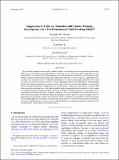| dc.contributor.author | Li, Harrison | |
| dc.contributor.author | Tziperman, Eli | |
| dc.contributor.author | Cronin, Timothy Wallace | |
| dc.date.accessioned | 2018-04-06T13:30:29Z | |
| dc.date.available | 2018-04-06T13:30:29Z | |
| dc.date.issued | 2017-08 | |
| dc.date.submitted | 2017-06 | |
| dc.identifier.issn | 0022-4928 | |
| dc.identifier.issn | 1520-0469 | |
| dc.identifier.uri | http://hdl.handle.net/1721.1/114578 | |
| dc.description.abstract | Arctic climate change in winter is tightly linked to changes in the strength of surface temperature inversions, which occur frequently in the present climate as Arctic air masses form during polar night. Recent work proposed that, in a warmer climate, increasing low-cloud optical thickness of maritime air advected over highlatitude landmasses during polar night could suppress the formation of Arctic air masses, amplifying winter warming over continents and sea ice. But this mechanism was based on single-column simulations that could not assess the role of fractional cloud cover change. This paper presents two-dimensional cloud-resolving model simulations that support the single-column model results: low-cloud optical thickness and dura tion increase strongly with initial air temperature, slowing the surface cooling rate as the climate is warmed. The cloud-resolving model cools less at the surface than the single-column model, and the sensitivity of its cooling to warmer initial temperatures is also higher, because it produces cloudier atmospheres with stronger lowertropospheric mixing and distributes cloud-top cooling over a deeper atmospheric layer with larger heat capacity. Resolving larger-scale cloud turbulence has the greatest impact on the microphysics schemes that best represent general observed features of mixed-phase clouds, increasing their sensitivity to climate warming. These findings support the hypothesis that increasing insulation of the high-latitude land surface by low clouds in a warmer world could act as a strong positive feedback in future climate change and suggest studying Arctic air formation in a three-dimensional climate model. Keywords: Inversions; Climate change; Cloud radiative effects; Cloud water/phase; Longwave radiation; Cloud resolving models | en_US |
| dc.publisher | American Meteorological Society | en_US |
| dc.relation.isversionof | http://dx.doi.org/10.1175/JAS-D-16-0193.1 | en_US |
| dc.rights | Article is made available in accordance with the publisher's policy and may be subject to US copyright law. Please refer to the publisher's site for terms of use. | en_US |
| dc.source | American Meteorological Society | en_US |
| dc.title | Suppression of Arctic Air Formation with Climate Warming: Investigation with a Two-Dimensional Cloud-Resolving Model | en_US |
| dc.type | Article | en_US |
| dc.identifier.citation | Cronin, Timothy W. et al. “Suppression of Arctic Air Formation with Climate Warming: Investigation with a Two-Dimensional Cloud-Resolving Model.” Journal of the Atmospheric Sciences 74, 9 (September 2017): 2717–2736 © 2017 American Meteorological Society | en_US |
| dc.contributor.department | Massachusetts Institute of Technology. Department of Earth, Atmospheric, and Planetary Sciences | en_US |
| dc.contributor.mitauthor | Cronin, Timothy Wallace | |
| dc.relation.journal | Journal of the Atmospheric Sciences | en_US |
| dc.eprint.version | Final published version | en_US |
| dc.type.uri | http://purl.org/eprint/type/JournalArticle | en_US |
| eprint.status | http://purl.org/eprint/status/PeerReviewed | en_US |
| dc.date.updated | 2018-03-30T17:51:28Z | |
| dspace.orderedauthors | Cronin, Timothy W.; Li, Harrison; Tziperman, Eli | en_US |
| dspace.embargo.terms | N | en_US |
| dc.identifier.orcid | https://orcid.org/0000-0002-7807-2878 | |
| mit.license | PUBLISHER_POLICY | en_US |
